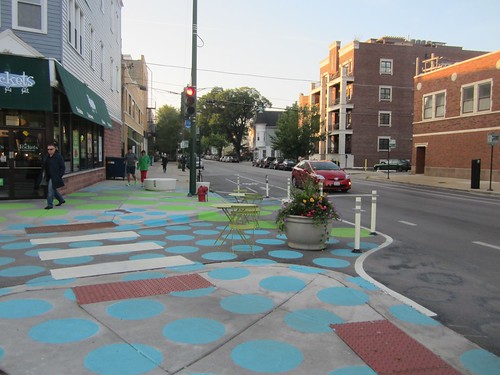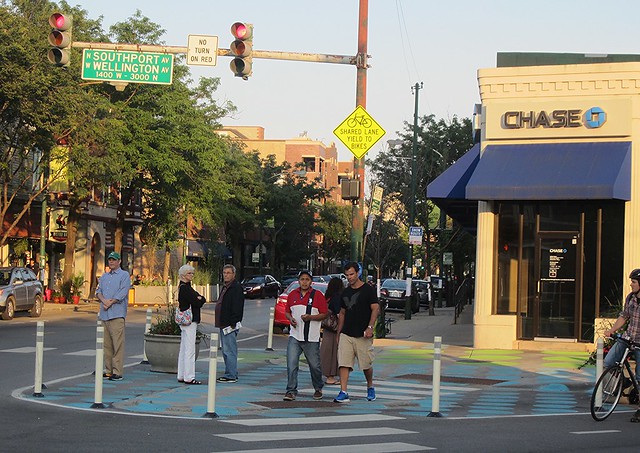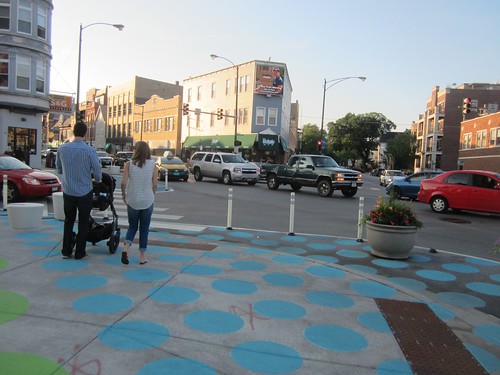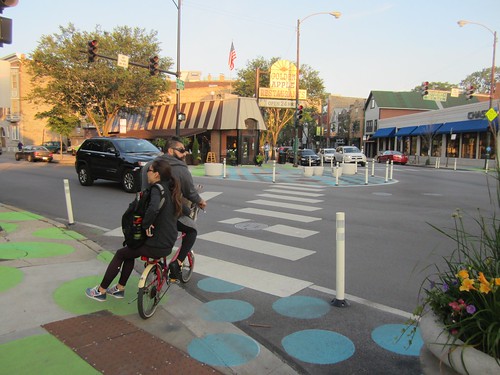As mentioned last Friday, Streetsblog Chicago will be on vacation from July 13-17 and will resume publication of Today’s Headlines and daily articles on Monday, July 20. There may be some occasional posts next week. Have a great weekend!
Tribune architecture critic Blair Kamin recently wrote a column slamming the "functional faults" of the Lincoln Hub placemaking initiative in Lakeview, which he claimed have led to a cacophony of horn blasting from aggravated motorists. I responded with a post acknowledging Kamin's valid criticisms that the seating plazas lack shade, and they don’t offer enough obvious physical protection from cars for some people to feel comfortable using them.
However, I also pointed out that a supposedly well informed urbanist like Kamin shouldn’t be lamenting the removal of dangerous slip lanes to make more space for pedestrians, simply because it forces drivers to slow down a bit. He wasn’t pleased:
@greenfieldjohn There's a line between responsible advocacy and turning a blind eye to the faults of projects you support. You've crossed it — Blair Kamin (@BlairKamin) July 7, 2015
An entertaining Twitter exchange ensued. Eventually Luis Monje, a local resident who launched an online petition against “Polka Dot Park,” got involved:
@streetsblogchi @BlairKamin @StreetsblogNYC I DOUBT 518 neighbors are "happy" about things. I have proof...do you? http://t.co/jjr7VEEVg4 — Luis Monje (@LuisMonje) July 7, 2015
Of course, not all of the signees on Monje's petition (there were 535 as of this afternoon) live in the neighborhood – some the addresses listed aren't even in Illinois. But Monje has a point: While his petition does suggest that a significant number of residents dislike the hub, there hasn’t been much in the media about neighbors who like the new street layout.
To get a sense of what kind support there is for the Lincoln Hub, I staked out the intersection last night between 7 and 8 p.m. and buttonholed passers-by. Granted, it wasn’t the thick of rush hour, but I saw no evidence of traffic problems and didn’t hear any of the “frustrated motorists honk[ing] their horns” Kamin wrote about.
All of the 16 people I spoke with were on foot, unless otherwise noted. I tried not to ask leading questions that would suggest I wanted a positive response, but simply asked for their opinion of the new street configuration.
The vast majority of the respondents told me they believe the curb extensions, including the removal of slip lanes, make the area safer and more pleasant for walking, and said the current layout doesn’t cause undue inconvenience for drivers. True, a couple of people did assert that the intersection is now a nightmare for motorists.
But, overall, this informal survey suggests that more neighbors may be in support of the Lincoln Hub than you might think from mainstream news reports, Kamin’s column, or Monje’s petition. Here are the responses, in chronological order, edited a bit for clarity.
It’s colorful. It’s probably a little bit nicer for pedestrians, because then you’ve got like a buffer zone around the curb where cars can’t come too close, because you got the big concrete flower pots and you've got these little [flexible posts].
-- Vishesh Narayan, lawyer
I think it makes it a little safer for cyclists. [The slip lane removal] keeps drivers from trying to cut the corners.
-- Jose Inui, works for the Wrigley Company, riding a bike
It’s a nice addition to the neighborhood. It gives it a little character, a place for people to hang out. To be honest, I didn’t see this intersection as particularly dangerous among all the intersections in the area, but it does give pedestrians more room.
-- Kevin Martin, works at the Chicago Mercantile Exchange
As a pedestrian, it doesn’t bother me a bit. It’s something interesting, it’s colorful. I like the these concrete forms here that you can sit on – they're kind of interesting. I would guess that the colors and the [flexible posts] with the reflectors contribute to safety.
-- Joe Evans, retired
Driving, it’s a little bit annoying, but it looks nice. I don’t know that it changed that much, safety-wise. I guess you have to stop sooner, right? I don’t know, I didn’t really notice it for two weeks, so I don’t think it changed that much. I guess crossing the street is a little easier because you don’t have to stop [on the pedestrian islands in front of the slip lanes] like you did before.”
-- Kristine Whall, bartender
It’s fine. It never bothered me how it was before, though. I suppose it makes it a little bit more safe. It’s probably a little bit better for crossing the street with the pylons out there. It’s about the same for driving – I haven’t really noticed a difference.
-- Anonymous
It's awful. Driving takes forever now. The lights are super-short. I commute to the suburbs and back every day. I can’t stand driving anywhere near here, when I have to go down Lincoln or Southport. You can’t make these right-hand turns anymore [while the light is red], so now I gotta wait behind people who are making right-hand turns. Only four or five cars get through a light at a time.
-- Pat Galligan, recruiter for an energy and engineering business
I think it’s very different. I’d like to know why they put up the little white poles. If it’s for safety, I’m all for it… I use the intersection more in a car than on foot. It still works fine for driving – I don’t think it impacts you, really.
-- Mike Checuga, real estate agent
Since I didn’t hear anything about it, and it just happened, and I live half a block away, I was wondering what is going on. But, having lived with it for a little while, I think it does make it a little more pedestrian-friendly. There were a lot of drivers who would zoom around the corners. I’ve read an article that says it makes it more difficult for drivers. I’m not so sure that it does.
So, my initial reaction was, who is the crazy guy who’s responsible for this? [That would be Lakeview Chamber of Commerce executive director Lee Crandell.] But my reaction now is that it is helpful, both safety-wise, and it adds interest to the corner. So I’m not one who would sign a petition saying it’s a terrible idea.
-- Dave Geilen [no relation to frequent SBC commenter Frank Geilen], retired manufacturing engineer
I think it’s great for the pedestrians. I think it works OK for drivers, once they get used to it, if they behave themselves. I like the configuration. I’ve yet to see [the seating] be fully utilized and I’d hope that in summertime it would come alive. But to me, the whole thing feels much safer, just by the fact that it gives more space to pedestrians in the intersection. I’ve been on this street for years, and it feels better to me.
-- Ron Hill, works at a company that does water damage mitigation, plays piano at Mariano’s supermarkets, “parishioner at the [nearby] Church of Scientology”
It’s fine with me because I don’t drive. But I think if you’re a person who comes here regularly and drives your car, it might be an imposition. It works fine for people on foot. I don’t see how the shorter crossing distances make a lot of difference, not to me anyway. Rather than this, what I’d really like to see is the #11 Lincoln bus put back in.
-- John Ringohfer, retired

As a pedestrian, I still don’t feel 100 percent certain that cars aren’t going to come whipping [over the flexible posts through the former] turn lanes. It’s a nice thought, but I don’t know if it’s great execution. I know that drivers aren’t happy with it. You can get stuck on Southport, if someone’s trying to make a left onto Wellington, you can get stuck there for a couple of light cycles. [A plaza adjacent to Southport was recently modified to make it easier for southbound motorists to pass left-turning cars.]
I’ve avoided driving through the intersection since this was put in. I take Ashland more than I normally would. I would normally go down Lincoln to go anywhere, and now I’m sticking to Ashland.
-- Brenna Essary, writer at an ad agency
I think it’s a great addition. I work on this block (south on Lincoln), and our business is right around the corner. It’s great for our business and the other surrounding businesses, as well as safety for pedestrians and families. It slows people down, makes people stop along [the business strip], kind of look at the storefronts a little bit more. As other businesses grow on this block, ours does as well, so that’s a good thing. But the most important thing about it is increased safety for cyclists, people on foot, and families with strollers.
-- Matt Savage, co-owner of Avery House photography and Smile Booth photo booths
I don’t think it makes that much of a difference. It’s kind of an eyesore in my opinion. I’m not really sure how it works for drivers. In some ways, maybe it helps them, but I could see that the turns are tighter. I can’t really say because I don’t drive.
This might be helpful for pedestrians. There’s more room for them. See that intersection over there? [Points to the corner in front of Chase Bank]. I used to get stuck on that little [pedestrian] island by the light, because the cars could turn in between that and the sidewalk, but now you don’t have to worry about getting stuck on that.
-- Liz Weber, marketing coordinator
Generally I like it. I like the tables, I like the color, I like the little places to sit, the little mushroom things. I’m a biker, and the traffic calming makes it a little bit narrower, so cars need to learn to slow down and not squeeze us into the barriers, but overall it’s great. I don’t think it changes the pedestrian traffic at all, unless they’re distracted by the colors. I guess the shorter crossing distances do give people a little more room, if they’re slower or older or something.
-- Rebecca Dill, works for a nonprofit foundation
It’s great for us, because we’re walking all the time over here, and it very clearly delineates walking zones, so it feels safer.
-- Lauren Levy, a lawyer “and a momma,” walking with her husband and their baby in a stroller







